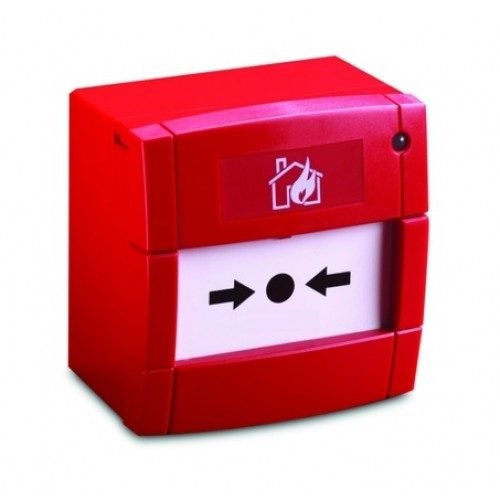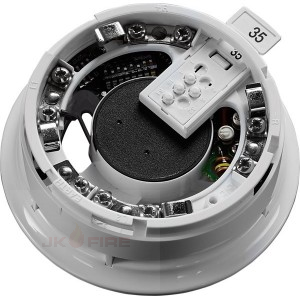-
 Mimics the characteristics of real flames Wide Spectral Output UV, Visible, Near IR, Mid-IR Tests many flame sensors types UV, UV/IR, UV/IR2, IR3, IR2, IR Portable with Rechargeable NiCd battery pack and charger Selectable Optical Output Type - Constant illumination, Regular flashing sources (range of frequencies), Irregular flickering sources (resembling flames) Selectable optical output intensity with LED bar graph indication Range typically 3 metres and beyond 30 Second timeout on each test Auxiliary 24Vdc supply for testing; Hochiki - Flame Sensor - Datasheet
Mimics the characteristics of real flames Wide Spectral Output UV, Visible, Near IR, Mid-IR Tests many flame sensors types UV, UV/IR, UV/IR2, IR3, IR2, IR Portable with Rechargeable NiCd battery pack and charger Selectable Optical Output Type - Constant illumination, Regular flashing sources (range of frequencies), Irregular flickering sources (resembling flames) Selectable optical output intensity with LED bar graph indication Range typically 3 metres and beyond 30 Second timeout on each test Auxiliary 24Vdc supply for testing; Hochiki - Flame Sensor - Datasheet -
 Key Features: Sensitive to flickering IR radiation Detects through films of oil, dust, water and ice Responds to flickering flames, including those invisible to the naked eye Compatible with Discovery and XP95 protocols Remote optical self-test function 90 field of view Up to 40m coverage
Key Features: Sensitive to flickering IR radiation Detects through films of oil, dust, water and ice Responds to flickering flames, including those invisible to the naked eye Compatible with Discovery and XP95 protocols Remote optical self-test function 90 field of view Up to 40m coverage -
 Sensitive to flickering IR radiation Detects through films of oil, dust, water and ice Responds to flickering flames, including those invisible to the naked eye Compatible with Discovery and XP95 protocols Remote optical self-test function 90° field of view Up to 40m coverage
Sensitive to flickering IR radiation Detects through films of oil, dust, water and ice Responds to flickering flames, including those invisible to the naked eye Compatible with Discovery and XP95 protocols Remote optical self-test function 90° field of view Up to 40m coverage -
 Pack of 10 transparent hinged covers which have been designed to fit on all Apollo manufactured manual call points. The covers help to provide extra security and protection against accidental operation.
Pack of 10 transparent hinged covers which have been designed to fit on all Apollo manufactured manual call points. The covers help to provide extra security and protection against accidental operation. -
 Key Features: ATEX & IECEx certified: II 1 G CENELEC/IEC Certified: Ga Ex ia IIC T4 Selectable output options: Conventional two-wire, 4-20mA, Latching or Non-latching, Relay Contacts - Fire/Fault, Pre alarm Class 1 sensitivity to EN54-10 detects 0.1m2 fire at 25m High optical interference immunity Selectable response speed Optical self-test Low power consumption IP65 rated Supply voltage 14 to 30Vdc Operating temperature -10C to +40C (T4) Operating temperature -10C to +55C
Key Features: ATEX & IECEx certified: II 1 G CENELEC/IEC Certified: Ga Ex ia IIC T4 Selectable output options: Conventional two-wire, 4-20mA, Latching or Non-latching, Relay Contacts - Fire/Fault, Pre alarm Class 1 sensitivity to EN54-10 detects 0.1m2 fire at 25m High optical interference immunity Selectable response speed Optical self-test Low power consumption IP65 rated Supply voltage 14 to 30Vdc Operating temperature -10C to +40C (T4) Operating temperature -10C to +55C -
 ATEX & IECEx certified: II 1 G CENELEC/IEC Certified: Ga Ex ia IIC T4 Selectable output options: Conventional two-wire, 4-20mA, Latching or Non-latching, Relay Contacts - Fire/Fault, Pre alarm Class 1 sensitivity to EN54-10 detects 0.1m2 fire at 25m High optical interference immunity Selectable response speed Optical self-test Low power consumption IP65 rated Supply voltage 14 to 30Vdc Operating temperature -10°C to +40°C (T4) Operating temperature -10°C to +55°C; Apollo - Datasheet Apollo - Installation Guide
ATEX & IECEx certified: II 1 G CENELEC/IEC Certified: Ga Ex ia IIC T4 Selectable output options: Conventional two-wire, 4-20mA, Latching or Non-latching, Relay Contacts - Fire/Fault, Pre alarm Class 1 sensitivity to EN54-10 detects 0.1m2 fire at 25m High optical interference immunity Selectable response speed Optical self-test Low power consumption IP65 rated Supply voltage 14 to 30Vdc Operating temperature -10°C to +40°C (T4) Operating temperature -10°C to +55°C; Apollo - Datasheet Apollo - Installation Guide -
 The Glavanic barrier is available in the XP95 IS range and the Orbis IS range. It can be installed in safe areas and ensures system integrity. Apollo Fire Detectors manufactures fire detectors designed for use in hazardous areas. This Product Guide gives information on the intrinsically safe (I.S.) version of the XP95 analogue, addressable range of smoke and heat detectors which have been approved by BASEEFA.
The Glavanic barrier is available in the XP95 IS range and the Orbis IS range. It can be installed in safe areas and ensures system integrity. Apollo Fire Detectors manufactures fire detectors designed for use in hazardous areas. This Product Guide gives information on the intrinsically safe (I.S.) version of the XP95 analogue, addressable range of smoke and heat detectors which have been approved by BASEEFA. -
 Apollo Indoor Intrinsically Safe Manual Call Point (470 ohm) - 55100-031APO The Conventional IS Manual Call Point has been designed to operate on conventional intrinsically safe fire detection systems. Designed specifically for use in atmospheres in which explosive mixtures are or may be present, certain design considerations must be observed
Apollo Indoor Intrinsically Safe Manual Call Point (470 ohm) - 55100-031APO The Conventional IS Manual Call Point has been designed to operate on conventional intrinsically safe fire detection systems. Designed specifically for use in atmospheres in which explosive mixtures are or may be present, certain design considerations must be observed -
 Apollo - Call Point - Datasheet Apollo - Call Point - Installation Guide Apollo - Call Point Cover - Product Guide
Apollo - Call Point - Datasheet Apollo - Call Point - Installation Guide Apollo - Call Point Cover - Product Guide -
 Two tones Two volume ranges 55-75dB(A) and 75-91dB(A) Individual and group addressing Unique acoustic self-test
Two tones Two volume ranges 55-75dB(A) and 75-91dB(A) Individual and group addressing Unique acoustic self-test -
 Key Features:; Loop Powered and compatible with XP95, Discovery and CoreProtocol* Incorporates a bi directional short-circuit isolator Automatic drift compensation Automatic reset Ground level Controller Automatic alignment compensation for building movement Laser assisted alignment for quick installation Allows for 2 detector heads per controller Up to 100m range Pre-alarm threshold EN 54-12 and EN 54-17 certified
Key Features:; Loop Powered and compatible with XP95, Discovery and CoreProtocol* Incorporates a bi directional short-circuit isolator Automatic drift compensation Automatic reset Ground level Controller Automatic alignment compensation for building movement Laser assisted alignment for quick installation Allows for 2 detector heads per controller Up to 100m range Pre-alarm threshold EN 54-12 and EN 54-17 certified -
 Key Features: Responds to stationary flames with no flicker Sensitive to low-frequency flickering IR radiation emitted by flames during combustion Compact flame detector which fits into Discovery or XP95 bases Loop-powered False alarms due to factors such as flickering sunlight are avoided by a combination of filters and signal processing techniques
Key Features: Responds to stationary flames with no flicker Sensitive to low-frequency flickering IR radiation emitted by flames during combustion Compact flame detector which fits into Discovery or XP95 bases Loop-powered False alarms due to factors such as flickering sunlight are avoided by a combination of filters and signal processing techniques













